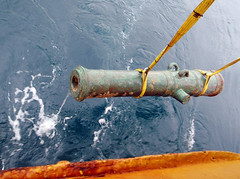
PREV ARTICLE
NEXT ARTICLE
FULL ISSUE
PREV FULL ISSUE
H.M.S. VICTORY WRECK MAY HOLD TROVE OF GOLD
Tom Kays forwarded this article, noting "Four tons of gold coins lost in 1744 may soon be within reach of marine archeologists." We could be reading about this for years to come, if indeed the coins are found.
-Editor
Four years ago, in the depths of the English Channel, explorers found the remains of a legendary British warship that sank in 1744 and lost more than 1,000 men. But intruders disturbed the site, dragging and damaging some of the 44 bronze cannons visible on the sandy bottom and hauling one of them away. The wreck's fate became a topic of public debate in Britain, and not just because of the nation's efforts to preserve its maritime heritage: documents suggested that the warship, the H.M.S. Victory, had carried a secret cargo of gold coins weighing about four tons. If melted down, the gold might be worth $160 million. But if sold for their historic value, the coins might fetch $1 billion. On Wednesday, the discoverers of the wreck said they had signed an agreement in which they would document and recover the artifacts, ending a long period of uncertainty. They praised the accord as an innovative new way for nations to save historic wrecks. "We've come up with the model that everybody's been looking for," said Gregory P. Stemm, head of the discovery team and chief executive of Odyssey Marine Exploration of Tampa, Fla., a publicly traded company that specializes in deep-sea exploration and recovery. In July 1744, the flagship Victory and a fleet of warships were sent to rescue a Mediterranean convoy blockaded by a French fleet at Lisbon. After chasing the French away, the Victory escorted the convoy as far as Gibraltar and then headed home. A raging storm hit the British fleet shortly after it entered the English Channel, and on Oct. 5, 1744, somewhere off the Channel Islands, the Victory went down with all hands. A month after the loss, a Dutch newspaper reported that the Victory had been carrying from Lisbon £400,000 destined for Dutch merchants. Odyssey has extensively researched the reliability of that report and concluded that the claimed shipment was most likely genuine and consisted of nearly four tons of gold coins. In early 2008, Odyssey found the wreck lying at a depth of about 260 feet, beyond the limits of most scuba divers. Odyssey plans to lower a robot for an archaeological survey of the site and to recover artifacts. The company says the position of every item will be plotted, with the entire project conducted according to the highest scientific and archaeological standards.
To read the complete article, see:
Deal May Yield World's Richest Shipwreck Trove
(www.nytimes.com/2012/02/02/science/wreck-of-british The Numismatic Bibliomania Society is a non-profit organization promoting numismatic literature. See our web site at coinbooks.org. To submit items for publication in The E-Sylum, write to the Editor at this address: whomren@gmail.com To subscribe go to: https://my.binhost.com/lists/listinfo/esylum All Rights Reserved. NBS Home Page Contact the NBS webmaster 
|
